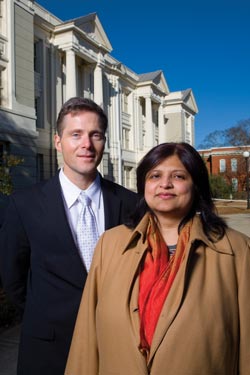Viewpoint
Balancing Trade and Security
A UGA center works to keep “dual-use” technologies away from conspirators while ensuring their application to benign commercial interests

Scott Jones is director of the Strategic Trade Program at the University of Georgia’s Center for International Trade and Security. Seema Gahlaut serves as CITS’s director of training and outreach. CITS is affiliated with UGA’s School of Public and International Affairs.
A godsend to kidney-stone sufferers is a machine called a lithotripter, which focuses sound waves to break the stones into smaller fragments that may then be more easily, and less painfully, passed. Key to this technology is something called a triggered spark gap—basically, a high-performance switch or spark plug—that also happens to be an essential component in the firing sequence for a nuclear weapon. As such, spark gaps are known as “dual-use” technologies.
In 2005, an international businessman was arrested for attempting to sell spark gaps, via South Africa and Dubai, to an end-user in Pakistan. But this particular customer, nominally a “hospital,” had put in an order for 200 of them, a number that was wildly outside the normal usage rate of five or six per year. Herein lies the problem: ensuring that spark gaps wind up in lithotripters and not in nuclear warheads.
Spark gaps are a very small part of the larger population of dual-use items that include, for example, certain chemicals, biotechnologies, advanced electronics, components of the nuclear-fuel cycle, machine tools, industrial furnaces, and navigation equipment. All such technologies have very legitimate commercial applications. In many respects, they are among the key ingredients of advanced economies, and thus we would wish to produce and apply them. Yet at the same time, how do we ensure that these very same commodities are not used to make weapons of mass destruction? Answering this question has been a primary mission of UGA’s Center for International Trade and Security (CITS).
In the United States, balancing trade and security has been no mean feat. The U.S. system of trade controls began during World War I and matured during the Cold War, but it has been struggling ever since. In fact, the main legal instrument for managing this balance—the Export Administration Act—lapsed in the summer of 2001, right before 9/11. Since then, Washington has been unable to establish a balance point between heightened security concerns about, say, nuclear terrorism and the need for U.S. companies to maintain their competitive edge, particularly in the high-tech sector.
This balance problem is not unique to the United States; it afflicts many other nations as well. Indeed, governments and companies in some developing countries may not even know that some of their industrial products can also be used to make weapons of mass destruction (WMD). For example, in 2003 a multinational network headed by a rogue Pakistani scientist was uncovered. It had recruited a Sri Lankan businessman to set up a factory in Malaysia, where a German technologist trained the unsuspecting local engineers to produce centrifuge parts that Libya had ordered for its nuclear-weapons program. The Malaysian government was surprised to learn that its industry was manufacturing such items, and it was embarrassed in that it had no laws making their application to WMD illegal.
Ironically, such setbacks have helped internationalize the issue and inspire action. In 2004 the U.N. Security Council passed a resolution requiring all nations to develop effective trade controls to prevent the spread and use of WMD, particularly by terrorist organizations. To assist in countries’ compliance with this resolution, CITS is working with governments like that of Malaysia. The Center helps them write new laws, set up licensing systems, train their customs officials and border security personnel to recognize dual-use technologies, and train people in industry to identify customers who might be attempting to buy items for use in WMD programs. With the support of U.S. and foreign governments, as well as private foundations, we have been able to bring some 80 officials from more than 20 countries to UGA in the past 24 months, and we have reached several hundred officials and industry representatives through our training programs abroad.
CITS’s work is part academic, part technical, and part diplomatic—but wholly rewarding, as it helps to prevent countries, as well as non-state actors, from developing WMD and delivery systems through the purchase of dual-use goods. Yet at the same time, this work also seeks to manage trade flows—to establish balance by assuring that products serving vital and benign commercial interests do get made, sold, and applied. The Center’s 20 years of such efforts reflect the best traditions of UGA in linking research with public service.
 |
